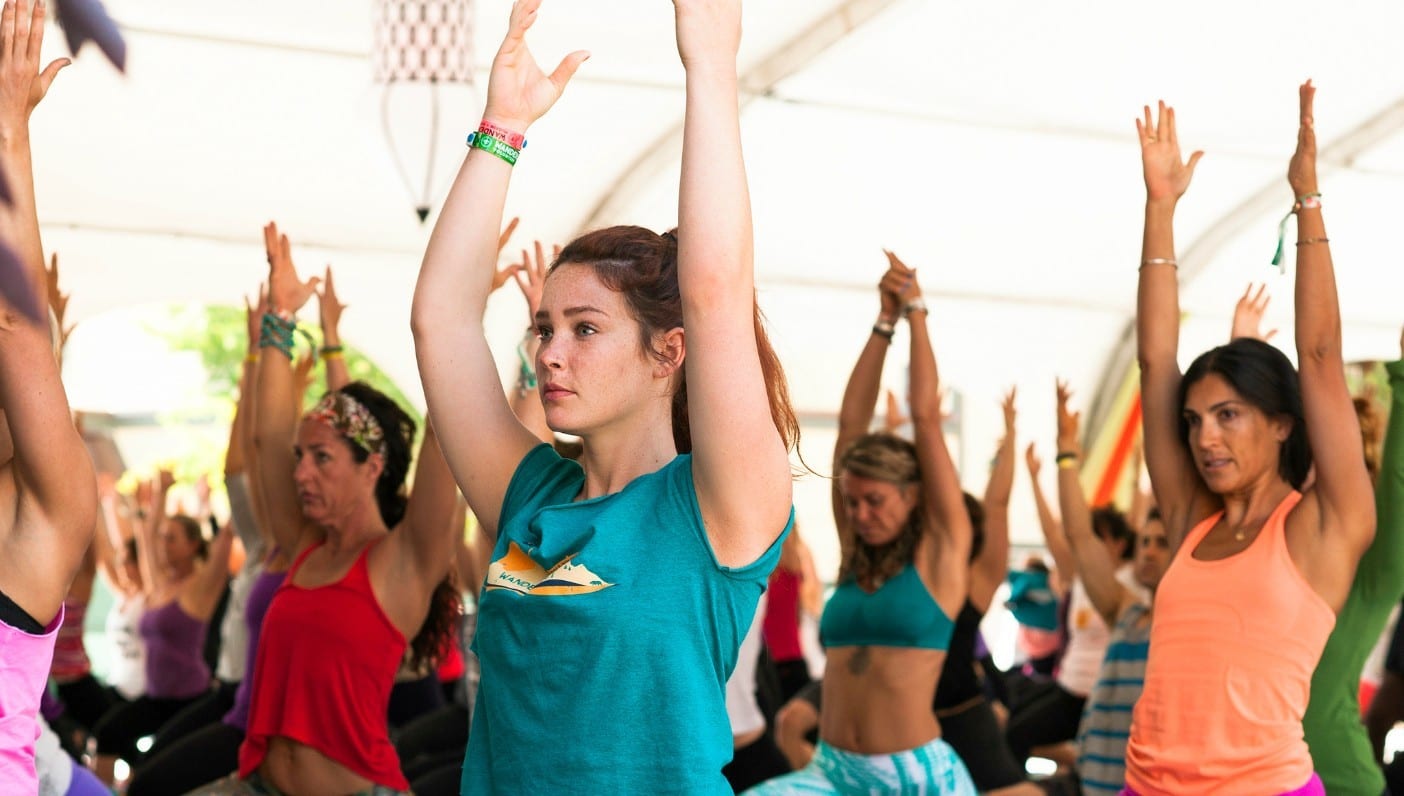
Begin your practice with Wanderlust TV – online yoga for every level.
It was near the end of class before, wild-eyed and panic-stricken, he waved me over to blurt out, “Are you going to adjust me and fix what I’m doing wrong yet? This is my first class—I’ve never done yoga before!”
Surprised by this outburst, I smiled at the student and kindly assured him that not only was he doing great, but that I would have never known he was a beginner. While I hadn’t provided him with any hands on adjustments until that plea for help, I can also truthfully admit that I hadn’t deemed it necessary. This undisclosed yoga-newbie was able to follow all of my cues and align himself correctly, and keep up with every asana. He was doing awesome—and yet, I can still picture the look of disbelief on his face even when I told him so. All the while in his mind, not only did he have no idea what he was doing—he thought he was doing it all wrong.
Yoga teachers do their best to keep their eyes on their students at all times—but the reality is that they’re only human—and if they’re adjusting someone else in a full public class, they can only be in one place at at time. I wish I had known this student was new to yoga, but it’s not exactly something a brand new student is always comfortable with sharing. In fact, if there’s one thing I can remember when I was new to yoga way back when… it’s that I wanted to remain invisible. And here is the paradox: While we secretly want to be invisible as yoga newbies while also hoping the teacher will correct us—we are also terrified that EVERYONE in the room is watching.
So why on earth would anyone want to share to a room filled with strangers, “Hi, I’m Andrea, and this is my first yoga class. I anticipate that I will have no idea what I am doing, so please, try to refrain from watching me.”
Not Always an Obvious Newbie
That new student in particular had assumed I would just be able to know that he was new, because he anticipated that his not knowing what he was doing would be obvious. He thought he’d stand out as a yoga newbie, and that I would therefore be all over him, correcting and adjusting him—because he was doing it all wrong. And granted, not every yoga newbie is the same—whether they stand out as such or not—but one thing IS for certain and it’s that NO ONE is watching. The self-defeating thoughts that some may have about yoga before they even begin are quite real, nonetheless—and if I could have given this guy (and any other closet newbies out there) a user’s manual, I would have. But more importantly, had I known prior to the start of class I would have said to him, “Relax, it’s just yoga.”
How many times have you recommended yoga to a friend or loved one and they’ve responded with reservation. “Oh, I’m not flexible enough to do yoga,” they’ll often say with self-defeat. They’ve already made assumptions about why they can’t do yoga before they’ve even rolled out a mat! We try to continue to encourage them, knowing it will help them in some way—be it through healing, health, or both—but the fear and anxiety is quite real for many yoga newbies. And the irony is that these are the people who quite possibly could benefit the most from the practice.
So let’s give the yogi newbies our continued support and a little extra nudge, and make their first experience easy. Below is a “Beginner Yogi’s User Manual” to help answer some of the questions they might anticipate before their first class. (What they won’t be able to expect, however, is the profound shift and transformation that will inevitably keep them coming back for more.)
What do I wear?
Dress comfortably in clothes you can move in. A simple T-shirt, or a top with support, combined with sweat pants or loose cotton pants would work fine for your first time. Do not feel obligated to purchase expensive yoga pants and a coordinating top. Do not be intimidated by other students who might be wearing trendy athleisure wear. Remember that they are here for themselves, just like you are here for YOU. Nobody cares what you are wearing—as long as you are comfortable in your own skin, you’re golden. Gradually invest in attire for your practice the same way you have begun to gradually invest in your health and wellbeing.
Where do I put my mat?
When you first walk into an empty studio you might not know which way the front of the room is. You can usually identify the front by looking for the altar—a Ganesh statue, candles, incense, singing bowls, etc.—and then place your mat vertically facing toward it. If you just can’t tell, then ask someone! Teachers get asked this all the time and are happy to answer. (Just like in life, there are no dumb questions when it comes to yoga.) When in doubt, follow the lead of other students as they come in. If your wish is to truly “remain invisible” throughout class, then place your mat in the back. Where you place your mat does not matter in the eyes of the teacher or other students, so position yourself in a way that allows you to feel safe.
Do I have to close my eyes?
Of course not! Though we recommend that you do while you get centered at the beginning of class and begin to quiet your mind, especially if a restorative posture or guided meditation is offered. And then of course it is highly recommended at the end of the class in Savasana, the final resting pose, so that you can fully reap the benefits of your physical practice. However, closing your eyes in a room filled with strangers is not comfortable for everyone as it makes us feel vulnerable. And that is totally OK!
What if I don’t want to be touched?
No problem. Hands on adjustments aren’t for everyone, and some teachers will ask before class if there is anyone who would prefer not to be touched. However, keep in mind that not all teachers do this, so if you feel strongly about your personal space, simply let the teacher know beforehand. You don’t have to announce it to the room—just pull him or her aside quietly. They will honor and respect your boundaries if you clearly define them.
What if I DO want to be touched?
To reiterate, all teachers do their best to keep their eyes on all of their students. But, if you’re noticing that the room is starting to fill up, you might receive more attention if you place your mat closer to the front of the room. Most teachers will try to work their way around the room as they go, but oftentimes they might need to use the space in the front to demonstrate poses. If you want a lot of adjustments, you’re more likely to receive them if you’re closer to the teacher.
What if I’m not strong or flexible?
You might not be able to do ALL of the poses your first class, but you will be able to modify to suit your body as needed. The great thing about an “All levels” class is that the teacher will offer options so that all abilities can get something out of the experience, without feeling like they’re being left behind on the sidelines. Of course there are classes tailored specifically for beginners, but know that you don’t have to limit yourself to those only. It’s important to remember that you are coming to yoga to connect to your body by way of your mind and breath. That’s all. You shouldn’t try to force yourself into shapes that your body isn’t ready for. Strength and flexibility is cultivated over time and the real challenge is accepting where you are in the moment, and honoring your own progress along the way.
Should I attempt advanced poses?
Short answer: No. And even if the teacher offers an advanced pose like Scorpion, Handstand or the full splits, know that again, these are often instructed as “options” for a reason. These poses are incredibly difficult and the students who are able to perform them have been practicing them for many, MANY years. This progress does not come overnight. The challenge here is, rather than defeating yourself by thinking, “Oh, I’ll never be able to do that, I should just give up,” try acknowledging the efforts that you did put forth instead. You showed up for yourself and did the best you could, which is more than enough. And the point of practicing yoga is not to “get good at yoga” anyway. The point of the practice is to help you get better at life.
What if I don’t understand Sanskrit?
Most teachers do not recite full 60–90 minute long classes in all Sanskrit. They understand that this is simply not fair to a population of all levels and abilities. While some choose to refrain from using it entirely, there are a good many others who carefully weave in Sanskrit terms with English, making the Sanskrit phrases naturally become familiar over time. You will hear the cues of where to place your feet and hands and how to move and align your body in English first, then followed by the Sanskrit name of the pose. But at that point, you’re already in the pose anyway.
Should I tell the teacher I’m new to yoga?
YES. While you may need to humble yourself to pull the teacher aside before the start of class and come out of the yoga newbie closet, they will SO appreciate that you did. There’s no need for a big fuss or announcement to the whole group—you can cultivate a sense of trust with your teacher by being upfront with them about where you’re at. This is also an ideal time to let the teacher know if you have an injury. Then they’ll know how best to instruct and adjust you, when to back off and of course, the pivotal moments when they know you might need that little extra nudge of encouragement. And just because the teacher pays more attention to you than anyone else, remember that nobody is watching you. If all else fails remind yourself to relax… because in the end, it’s just yoga.
—
 Andrea Rice is a Senior Writer for Wanderlust Media. She is also a freelance writer, editor, and yoga teacher. Her work has appeared in The New York Times, Yoga Journal, SONIMA, mindbodygreen, AstroStyle, and other online publications. Connect with her on Instagram, Twitter, and on her website.
Andrea Rice is a Senior Writer for Wanderlust Media. She is also a freelance writer, editor, and yoga teacher. Her work has appeared in The New York Times, Yoga Journal, SONIMA, mindbodygreen, AstroStyle, and other online publications. Connect with her on Instagram, Twitter, and on her website.